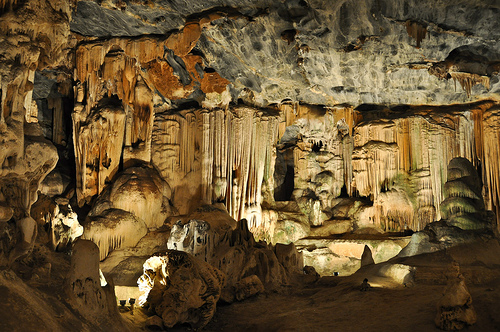

Location: Oudtshoorn, Western Cape Province Map
Length: 3.3 mi (5.3 km)
Cango Caves are located near a town of Oudtshoorn, Western Cape Province in South Africa. Cango Caves are underground tunnels with a total length of 3.3 mi (5.3 km), although only one forth are actually open to the public. Descent into this natural caverns are accomplished by the tour guides that take you through safe paths. Independent exploration should be done in groups and after agreement with the local officials. Some people still try to find the extension of Cango Caves that is said to be found in 1898 by cave's original guide Mr. Johnny van Wassenaer. He claimed to have walked for over 29 hours and estimated this tunnel to be at least 274 meters below ground and 25 km long. No one was able to support this claim, but there is no shortage of volunteers. Cango Caves were formed through erosion of the Precambrian limestone and its formation still goes on. So be careful and watch where you step and where you put your hand. It might not be as solid as you would hope it would be.
Professor A.J.H. Goodwin (University of Cape Town),
archaeologist, undertook a systematic exploration of the caves from
1930. Various arrangements of stones and paintings indicate in
particular that men inhabited the entrance to the caves for a long
period in the Mesolithic and Neolithic periods.
The caves were
discovered in 1780 by a local farmer named Van Zyl. The room he
discovered first is named in his honor (Van Zyl Hall, the length of a
football field).
A second room was discovered in 1792. The caves
then enjoyed a certain reputation and were regularly visited.
The
legends of the caves
Johnny van Wassenaer, who was the first official
guide to the caves, reportedly walked 29 hours to identify the end of
the caves in 1898. He estimated he walked 25 kilometers and descended
275 meters from the entrance. It would have followed an underground
river. No passage has so far been found that matches this description.
The first exploratory expedition was carried out in 1897, mapping
twenty-six rooms. In 1956, the South African Spelaeological
Association was appointed to carry out an exhaustive mapping of the
Cango Caves, and search for possible other entries.
This
research indicated that the caves had a length of 775 meters, and
that there was no height difference of more than 16 meters. This
network is generally referred to as “Cango I”. The closest point to
the surface is at the top of Devil's Kitchen, 52.6 meters from the
surface.
In 1972, James Craig-Smith, Luther Terblanche and
Dart Ruiters widened an obstructed passage and discovered what would
henceforth be known as "Cango II", which extends 270 meters beyond
the Devil's Kitchen. At the end of Cango II was a well 20 meters
high, leading to a flooded hall, the water from which flowed towards
Cango I.
In August 1975, during a symposium on cave biology,
an exploration team, led by Florus Koper, evacuated most of the
water present and walked through what had previously been an
underwater passage. This uncovered yet more rooms and caves, called
"Cango III", which added about 1,000 meters in length to the caves.
The most important section is 300 meters long.
Digby Ellis
and Dave Land added 290 meters to Cango III when they discovered a
passage in December 1977; Another 90 meters were added in June 1978.
All these additions were inventoried in August 1978 by Dave Land,
Charles Maxwell, Brian Russell and Doug Crombie.